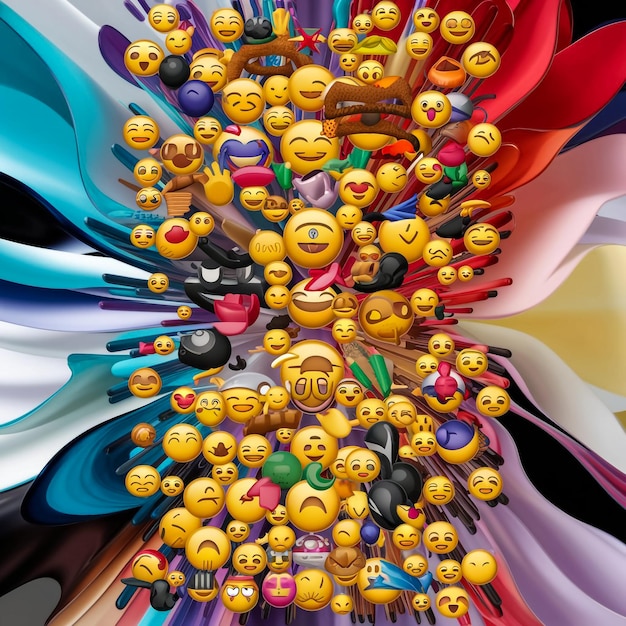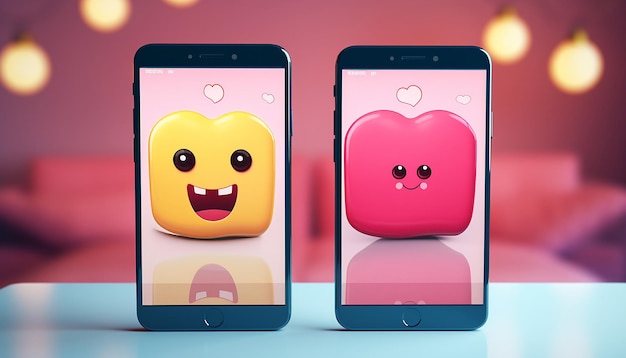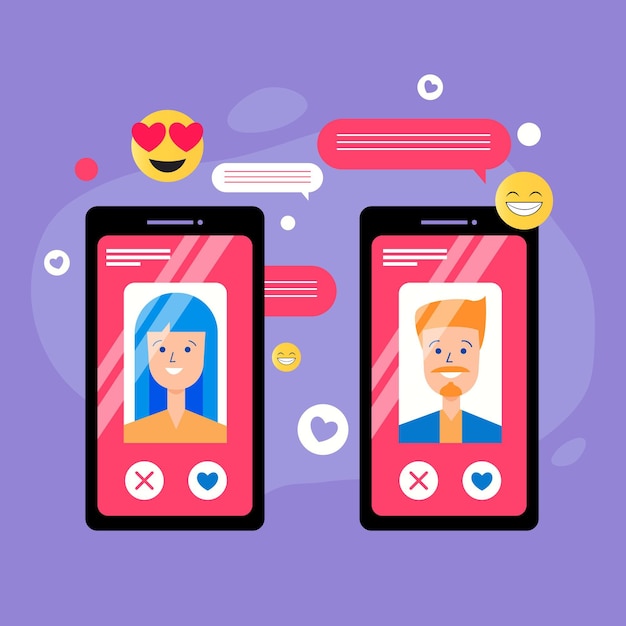The Evolution of Emojis: A Look at Our Changing Digital Language

The Evolution of Emojis: How Our Digital Language is Changing reveals how these small digital icons have transformed communication, reflecting cultural shifts and evolving technological landscapes in the United States and globally.
Emojis have revolutionized the way we communicate, transcending language barriers and injecting emotion into our digital conversations. The Evolution of Emojis: How Our Digital Language is Changing is a fascinating journey through the history and cultural impact of these expressive icons.
The Origins of Emojis: From Japan to Global Phenomenon
The emoji’s journey from a niche Japanese invention to a global communication staple is a testament to its simple yet powerful ability to convey emotion. Understanding the origins of emojis provides valuable insight into why they’ve become so integral to our digital lives.
The Birth of Emojis in Japan
Emojis were first created in Japan in the late 1990s by Shigetaka Kurita, a member of the team working on NTT DoCoMo’s i-mode mobile internet platform. Frustrated with the limitations of text-based communication, Kurita sought a way to add emotional context to messages.
- Kurita designed 176 characters, each a 12×12 pixel image, inspired by manga, kanji, and emoticons.
- These early emojis were intended to convey a range of emotions and concepts, from happiness and sadness to weather symbols and modes of transportation.
- The introduction of emojis onto the i-mode platform proved immensely popular, quickly spreading among Japanese mobile users.
Global Adoption and Standardization
As mobile technology advanced, emojis began to make their way outside of Japan. However, the lack of standardization presented challenges, as different platforms and devices displayed emojis differently, or not at all.

- In the late 2000s, the Unicode Consortium, a non-profit organization responsible for maintaining text standards across computers, began the process of standardizing emojis.
- This standardization ensured that emojis would appear consistently across different platforms, paving the way for wider adoption.
- With the introduction of emoji support on major mobile operating systems like iOS and Android, emojis became a global phenomenon, forever changing the landscape of digital communication.
The story of emojis starts in Japan, propelled by standardization for use across languages and platforms, becoming an integral part of our worldwide technology and cultures.
How Emojis Have Impacted Communication
Emojis have profoundly impacted the way we communicate, adding layers of nuance and emotion to our digital interactions in a way never seen before. They have become an indispensable tool for expressing ourselves, especially in the fast-paced world of online communication.
Enhancing Emotional Expression
One of the most significant impacts of emojis is their ability to enhance emotional expression in text-based communication. Text alone can often be misinterpreted or lack the emotional context needed to fully convey a message.
- Emojis provide a visual cue that helps clarify the sender’s intent and emotional state.
- They can soften the tone of a message, making it appear more friendly and approachable.
- Emojis can also convey complex emotions or sentiments that would be difficult to express using words alone.
Bridging Language Barriers
Emojis have also proven to be effective for bridging language barriers, as they can often convey meaning regardless of the recipient’s native language. This makes them particularly useful in multicultural or international communication contexts.
- A simple smiley face 😊 can communicate happiness or agreement universally, regardless of language.
- Emojis can act as visual shorthand, reducing the need for lengthy translations or explanations.
- They can also create a sense of connection and understanding among people from different linguistic backgrounds.

The Rise of Visual Communication
The widespread use of emojis has contributed to the rise of visual communication, where images and symbols are used to convey meaning instead of text. This trend is particularly evident in younger generations who have grown up with emojis as an integral part of their digital lives.
Ultimately, the significance of communication via emojis lies in its capability to enrich written communication, break down language barriers, and assist the development of visual language practices.
The Changing Meaning of Emojis
Emojis, like any language, evolve over time, with their meanings shifting and adapting to cultural trends and social contexts. What an emoji meant five years ago might not be what it means today, highlighting the dynamic nature of digital communication.
Emoji Drift and Interpretation
Emoji drift refers to the phenomenon where the meaning of an emoji changes over time, often due to cultural shifts or new interpretations by users. This can lead to misunderstandings or unintended consequences if the sender and recipient have different understandings of an emoji.
- The meaning of an emoji can vary depending on the context in which it is used.
- Cultural differences can also play a role in how emojis are interpreted.
- Even within the same culture, different age groups or subcultures may have different understandings of certain emojis.
Emojis and Generational Differences
Generational differences also play a significant role in the changing meaning of emojis. Younger generations, who have grown up with emojis as a primary form of communication, often use them in ways that older generations may not understand or appreciate.
- Younger users are more likely to use emojis ironically or sarcastically, while older users may interpret them more literally.
- Certain emojis may become associated with specific trends or memes, further complicating their interpretation.
Monitoring the changing significance of emojis is crucial to efficient contact in today’s ever-changing digital world, avoiding misunderstandings and keeping up with emerging linguistic styles.
Emojis in Business and Marketing
Emojis have permeated the world of business and marketing, offering brands a unique opportunity to connect with their audiences in a more engaging and personal way. However, using emojis effectively in a professional setting requires careful consideration of context, audience, and brand identity.
Humanizing Brand Communication
Emojis can help humanize brand communication by adding a touch of personality and emotion to otherwise sterile or formal messages. This can make brands appear more approachable and relatable, fostering stronger relationships with customers.
- Emojis can be used in social media posts, email marketing campaigns, and even customer service interactions to create a more engaging and memorable experience.
- However, it’s important to use emojis judiciously and ensure that they align with the brand’s overall tone and messaging.
Increasing Engagement and Click-Through Rates
Studies have shown that using emojis in marketing materials can increase engagement and click-through rates. Visual cues can capture attention and make messages stand out in crowded inboxes or social media feeds.
- Emojis can be used in email subject lines to increase open rates.
- They can also be used in social media posts to encourage likes, comments, and shares.
Properly employing emojis in business and advertising provides a way for makes to greatly enhance their brand’s appeal, promote audience participation, and eventually enhance marketing operation results.
The Future of Emojis: What’s Next?
As technology continues to evolve, so too will the world of emojis. From more inclusive representation to more personalized expression, the future of emojis promises to be even more dynamic and engaging than ever before.
More Inclusive and Diverse Emojis
One of the key trends in the future of emojis is a push for more inclusive and diverse representation. There is a growing demand for emojis that reflect the diversity of the global population, including different skin tones, genders, sexual orientations, and disabilities.
- The Unicode Consortium has already taken steps to address this issue by introducing modifiers that allow users to customize the skin tone of certain emojis.
- However, there is still work to be done to ensure that all members of society feel represented in the emoji landscape.
Animated and Personalized Emojis
Another trend in the future of emojis is the rise of animated and personalized emojis. Animated emojis, also known as animated stickers or GIFs, add a new layer of visual expressiveness to digital communication.
- Personalized emojis, such as Bitmoji or Memoji, allow users to create avatars of themselves and use them in messaging apps and social media platforms.
- These trends suggest a future where emojis are not just static symbols but rather dynamic and customizable representations of individual identity and expression.
The development of emojis is primed to adopt better inclusion, variety, and personalization, consequently building them into an even more vital component of our virtual communicating experiences.
Emojis and Mental Health
The relationship between emojis and mental health is a nuanced one, with both potential benefits and drawbacks. While emojis can be a valuable tool for expressing emotions and connecting with others, they can also contribute to miscommunication or emotional overload.
Emotional Expression and Support
Emojis can be a helpful outlet for emotional expression, particularly for those who struggle to articulate their feelings in words. They can provide a quick and easy way to communicate emotions like happiness, sadness, anger, or anxiety.
- Emojis can also facilitate emotional support by allowing people to express empathy or solidarity with others who are going through a difficult time.
- A simple heart emoji ❤️ can convey love, care, or support in a way that words sometimes cannot.
Potential Drawbacks and Misinterpretations
However, it’s important to recognize the potential drawbacks of using emojis to communicate emotions. Emojis are inherently ambiguous, and their meaning can vary depending on the context, culture, and individual interpretation.
- This can lead to miscommunications or misunderstandings, especially when dealing with sensitive or complex emotions.
- Relying too heavily on emojis may also prevent individuals from developing more nuanced and sophisticated ways of expressing themselves.
Even though emojis offer options for emotional expression and assistance, it’s critical to know their limits and possible disadvantages, particularly when processing intricate mental or psychological wellness matters.
| Key Point | Brief Description |
|---|---|
| 😊 Origins | First created in Japan in the late 1990s. |
| 🌐 Impact | Enhance expression and bridge language barriers. |
| 📈 Business Use | Humanize communication, increase engagement. |
| ❤️ Mental Health | Can express emotions but may cause misinterpretation. |
Frequently Asked Questions
▼
Emojis were first created in 1999 by Shigetaka Kurita, a Japanese interface designer working for NTT DoCoMo, a Japanese mobile operator. He designed them as a way to help facilitate electronic communication.
▼
Emoji drift refers to the phenomenon where the meaning of a particular emoji changes over time or varies across different cultural contexts. This can lead to misunderstandings in communication.
▼
Emojis can humanize brand communication and increase engagement. They help capture attention in social media and email marketing, making content more relatable and interactive.
▼
Emojis can aid in emotional expression, especially for those who have difficulty expressing feelings. They allow easy communication of emotions and help show empathy in digital interactions, which can facilitate emotional support.
▼
The future includes a focus on greater diversity and inclusion, ensuring representation across different demographics and abilities. Expect to see more personalized and animated emojis, offering richer, more expressive digital communication.
Conclusion
In conclusion, the evolution of emojis reflects our changing digital language and culture. From their humble beginnings in Japan to their current status as a global phenomenon, emojis have transformed the way we communicate, express ourselves, and connect with one another. As technology continues to advance, it will be exciting to see how emojis continue to evolve and shape the future of digital communication.
